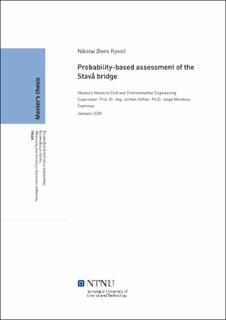| dc.contributor.advisor | Prof. Dr.-Ing. Jochen Köhler | |
| dc.contributor.advisor | Ph.D. Jorge Mendoza Espinosa | |
| dc.contributor.author | Nikolai Øwre Ryvoll | |
| dc.date.accessioned | 2020-06-04T16:03:49Z | |
| dc.date.available | 2020-06-04T16:03:49Z | |
| dc.date.issued | 2020 | |
| dc.identifier.uri | https://hdl.handle.net/11250/2656759 | |
| dc.description.abstract | Denne masteroppgaven handler om beslutningsprosessen angående hva man
skal gjøre med Stavåbrua. Hovedmålet med oppgaven er å finne ut hva man skal
gjøre med Stavåbrua. Oppgaven tar ikke bare for seg på de rene konstrukjonstekniske
vurderingene. Den inneholder også en samfunnsøkonomisk vurdering
og det organisatoriske aspektet knyttet til beslutningsprosessen er berørt.
Ulike besluttningslaternativer ble etablert. En samfunnøkonomisk kostnadsnytte
analyse ble gjennomført for å finne kostnadene av implementering av de
ulike alternativene. Mange av alternative kunne allerede på et tidlig stadium bli
forkastet grunnet høye kostnader.
Lastkapasitietsberegningene er gjennomført med probabilistiske regnemetoder.
I den innledende prosjektoppgaven ble det funnet at trafikklasten er av stor betydning
for bruas sikkerhet. En egenutviklet lastmodell som er basert på forskrift
om bruk av kjøretøy er brukt. Lastmodellen tar hensyn til antall kjøretøy som
kjører over brua. Kapasiteten til to ulike tverrsnitt har blitt vurdert.
Beregningene antyder at sannsynligheten for brudd er for høy. Det burde derfor
iverksettes tiltak for å redusere bruddsannsynligheten. De samfunnsøkonomiske
beregningene antyder at å forsterke brua er den mest kostnadseffektive måten å
redusere bruddsannsynligheten. | |
| dc.description.abstract | This master thesis is about the decision-making process regarding the Stavå
bridge. The main aim of the thesis is to find out what to do with the Stavå bridge.
Different aspects of the decision-making process are considered. Namely, the
organizational process of reassessing old structures, the socio-economics, and
the structural capacity. Various decision alternatives have been established. A
cost-benefit analysis has been carried out to find the cost of the alternatives. Several
of the decision alternatives could already at an early stadium be dismissed
because of the high costs.
Probabilistic methods were used to calculate the load-bearing capacity. In the
project work, it was found that the traffic loads are of great importance for the
safety of the bridge. The Norwegian rules on motor vehicles are used as a basis
for the development of a site-specific load model. The load model takes the
number of vehicles into account. The capacity of two different cross-sections
has been assessed.
The calculations indicate that the probability of failure is too high. Based on the
findings, it is recommended to implement measures to reduce the probability
of failure. The socio-economic considerations indicate that to strengthen the
bridge is the cheapest alternative. | |
| dc.language | eng | |
| dc.publisher | NTNU | |
| dc.title | Probability-based assessment of the Stavå bridge | |
| dc.type | Master thesis | |
